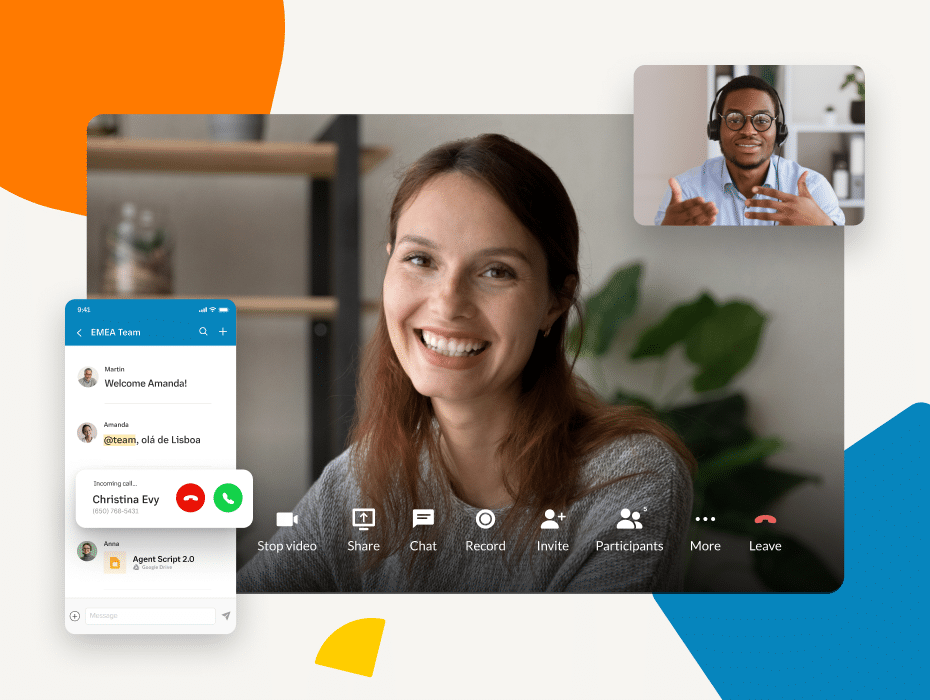Highlights:
- 73% of employees want flexible work options to remain after COVID.
- Flexible work offers tremendous benefits, including reducing stress, improving productivity, and higher job satisfaction.
- Remote work is just one of the many options businesses can offer flexibility.
- Supporting a flexible workforce requires a communications solution that includes both video calls and team messaging. Check out RingCentral Video to learn more.
After decades of office nine-to-fives, more and more of us have become aware of just how important a good work-life balance is.
And it’s not just for the employees. Employers are also set to benefit from this workplace culture shift. The modern workplace is all about employee experience. That’s because employee flexibility and employee satisfaction are the catalysts for so many other brilliant outcomes (we’ll get to that in just a bit).
More and more businesses have woken up to the importance of job satisfaction, and it’s fast becoming a key criterion for job seekers the world over.
⭐ Your work-from-anywhere future ⭐
Here’s the secret to a successful hybrid and remote-first workplace.
What is workplace flexibility?
Workplace flexibility is an increasingly common phenomenon in which employees are given the opportunity to do their job in a way that suits their lifestyle and responsibilities.
In other words, it is the antidote to the nine-to-five and an essential part of any modern company’s culture.
A flexible workplace realizes that how and when their employees work best will vary depending on their individual circumstances. The important thing is that work gets done well, not that it gets done in a prescribed timeframe or environment.

A flexible workplace will consider the needs of both employee and employer with flexible work arrangements that support improved work-life balance.
And that doesn’t just mean remote working (though this could be part of it).
Flexible arrangements could include:
- Flexible work shifts
- Shifting arrival and departure times
- Part-time employment options
- Shared employment options
- Remote working options
- Unlimited paid time off
- Family or medical leave
- Caregiving leave
- Sabbaticals
Employers that embrace flexible arrangements find that it’s excellent for talent acquisition and retaining top talent, while promoting a workplace culture built on trust and commitment.
Plus, with more and more employees now expecting flex-working arrangements it’s no longer merely an option. Flexible working is now an essential business practice.
63% of employee respondents believe that the standard eight-hour day is on the way out. LinkedIn data now shows that women and Gen Z are more likely to apply to remote positions when job searching.
How do flexible hours work?
Flexibility works best when both employees and employers embrace a flexible mindset. In other words, it can’t just be a one-way street where employees get all the benefits.
Employers and employees must find a balance that works for them. Employees can demonstrate commitment and flexibility in a number of ways.
For example:
- Flexible working hours
- Learning useful new skills
- Covering for a colleague who is on leave
- Working extra hours from time to time
- Taking a problem-solving approach to any issues that crop up.
Stay informed with RingCentral
In exchange for more flexible options, employees can reciprocate with increased productivity and top-quality work.
For customer support teams, or contact center agents, for example, technology is now making it eminently possible to work out of the office. Features such as business phone service, virtual call center and CCaaS can help to easily facilitate this switch.
What’s more, flexibility in employers is about much more than just altered timetables. Flexible employers accommodate individual working styles, offering feedback, guidance, and recognition on a regular basis.
How do you implement flexibility at work?
There are so many different ways of being a flexible workplace. No employer is going to be able to facilitate every single type of flex work, and that’s okay.
The flexible arrangements you make for your employees will depend on everything from your particular industry to the size of your business. The important thing is to come up with some options that meet your needs as an employer and those of your employees.
You might even want to brainstorm this process with your team members directly. Identify your employees’ pain points. Then make arrangements that best suit everyone’s needs.
Let’s take a look at some typical flexible work arrangements.
1. Flexible arrival and departure times

This is one of the most popular types of benefits packages. Flexible scheduling has become increasingly common as more and more of us realize that prescribed working hours just aren’t feasible for the majority of working people. We’re not robots after all.
People have lives and responsibilities outside the office. They might need to pick the kids up from school. They might have additional caregiving responsibilities. That shouldn’t bar them from employment. And that shouldn’t bar you, as the employer, from this pool of talent.
One way of achieving this kind of flexibility is to become more deadline-oriented. Instead of incessantly monitoring when your employees clock in and out of the office, be more interested in them delivering work on time. Not only is this more flexible, but it promotes a culture of productivity, prioritizing results over superficial quotas.
Alternatively, mobilize a call center management or workforce management tool to help monitor attendance. That way, whether your employees come into the office at 9 a.m. or 11 a.m. after dropping the kids at school, you’ll know exactly how many hours they’re working each day of an average week.
2. Remote working or telecommuting

Remote working is becoming more and more accepted as a legitimate option for office employees. After all, if you can do your job just as well from another location, why not? Tomorrow’s workplace isn’t tethered to an office.
Workers want freedom, and the COVID-19 pandemic only accelerated this trend. Offices are going through a cultural shift towards hybrid work and the number of people choosing to work as freelancers is also on the rise.
In fact, not offering this kind of flexibility could leave your business at a disadvantage when it comes to attracting top talent. Flexible workplaces should give employees the freedom (when possible) to work from anywhere. (A VoIP phone service can help make remote working easy.)
Not only is telecommuting desirable for employees, but it’s also proven to boost employee productivity. People who are able to work remotely are 24% more likely to be happy and productive.
And this doesn’t mean you have to go 100% remote.
Most businesses have some work that can be done remotely, so allowing employees one or two days working from home each workweek strikes a great balance. In fact, companies that allow remote work have a 25% lower employee turnover rate than those that don’t. Remote and hybrid work is one of the biggest HR trends of recent years. According to a study by Zippia, more than 70% of companies are working on or already using a hybrid work model. Flexible working helps businesses attract, hire, and retain top talent. It really is a win-win situation for all involved.
3. Compressed workweeks
Contrary to popular belief, compressed work hours don’t actually mean working less. Companies that facilitate compressed working hours simply reallocate standard working hours into fewer (or more) working days than would be normal for an average working week.
An employee could work a four-day week increasing the number of hours they work each day. Likewise, an employee could work a six-day week decreasing the number of hours they work each day. In both scenarios, despite the flexible work hours, the annual hours worked remain exactly the same.
4. And that’s not all
Flexible-hours contracts, remote work, and compressed working hours may be the most talked-about flexible workplace practices, but a flexible job can go far beyond this.
Other types of working arrangements include:
- Caregiving leave: Businesses recognize the complexity of family life and provide flexibility for family care in times of illness or reasonable need.
- Term-time work: A great one for parents. Employees can remain on permanent contracts while taking either paid or unpaid leave during school vacations.
- Job sharing: A bit like part-time working contracts, except two (or more) employees share the responsibilities of one full-time job.
- Unlimited PTO: Unlimited paid time off is a highly attractive offering for employees because it gives them the peace of mind that they can take a sick day when they need to.
Why flexibility is implemented in the workplace
Flexibility in the workplace is super important for employee well-being and office workflows in equal measure. For far too long employees have been treated like robots and stripped of their individuality and personal needs or obligations.
The truth is, everyone is different. And the more businesses come to realize this, the more they seek to gain. A flexible workplace is mutually beneficial. Workers achieve superior work-life harmony, and companies start to see the fruits of their employees’ best selves.
Flexibility offers several advantages for employees (and employers)

For businesses, that means increased employee retention and increased employee loyalty, productivity, and engagement. And at the end of the day, that equates to a better bottom line.
What’s more, remote workers actually save companies money. Think about how much you could save simply by not renting out a permanent office space and forking out for utilities.
On the other side of things, employees that feel accommodated and valued as individuals work harder, with more drive to accomplish projects well, take on new responsibilities, and help out with extra workloads from time to time. A joy for project management.
But why is this? Why is flexible working so good for employees?
1. Prioritize families
Family life needs a flexible schedule and working environment. Working parents have responsibilities. The nine-to-five won’t always fit, but that doesn’t mean they can’t ace their jobs. If your employees have families, they might just need to work outside the box from time to time. Facilitating a flexible approach helps your employees do their best work.
2. Reduce stress and burnout
Traditional office working environments can be seriously stressful. Research shows that improving flexibility at work is good for your employees’ mental health. In companies that introduce flex-time arrangements, stress-related issues fall.
3. Health and wellness
Would you believe it, flex work can even benefit the physical health of your employees. It’s true. Think about how hard it is to fit daily exercise into a typical workday. Especially if you’ve also got to factor in commuting time into and out of work. Employees’ commutes can take hours out of each day. When workers have a flexible work schedule, or work from home, time for exercise is much easier to come by.
4. Employee morale
Offering flexible working to your employees is a way of showing them that you trust them. Feeling trusted is a direct line to office morale and employee loyalty. You’re telling your workers that their needs matter—because they do!
5. Boost productivity
Finally, the natural outcome of all of this employee empowerment is great work. When employees feel valued, heard, and taken care of, they inevitably work harder. They enjoy their jobs more, and that means super-high productivity levels all around.
How to facilitate flexible working in your business
We’ve talked a lot about why flexible working is so great. But how can you start mobilizing this approach in your own business?
Enabling flexible work requires the right communication solutions. You’ll need good management software on your side in order to manage and administer disparate working timetables and locations. It’s a lot to keep track of.
RingCentral Video offers unlimited video meetings and team messaging completely free. Perfect if you’re introducing remote work options for your employees or if you’ve got people in and out of the office at different times of the day.
Features include:
- HD meetings
- Up to 100 people
- Screen sharing
- Connected calendars
- Chat and share
- Record meetings
Glip unifies video and messaging into one single, easy-to-use platform so that employees can collaborate from anywhere in the world. A huge asset for an aspiring flexible workplace.

Free and unlimited video meetings and team messaging. Seriously.
Flexibility reigns supreme
The traditional workday is fast becoming a thing of the past. And, really, that’s because it just doesn’t make sense anymore. Facilitating flexible work options will give your business a competitive edge. Employees today have busy lives inside and outside the office. Flexible working makes life easier and outputs better. It’s really as simple as that.
Updated Aug 21, 2024












